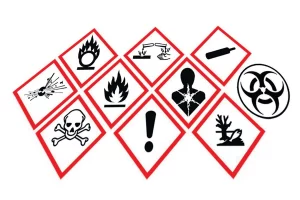The Globally Harmonized System (GHS) and the Workplace Hazardous Materials Information System (WHMIS) are two systems created to guarantee the safe handling, storing, and use of hazardous products. A standardised document that offers crucial details about a hazardous material or mixture is the WHMIS GHS Safety Data Sheet (SDS). Each section of a WHMIS GHS Safety Data Sheet will be briefly explained in this post.
- Identification: This section includes the product name, manufacturer information, product code, and emergency phone number. This information is crucial for identifying the substance in case of an emergency.
- Hazard Identification: This section describes the hazards associated with the substance, including physical, health, and environmental hazards. This section also includes the hazard classification and labeling information.
- Composition/Information on Ingredients: This section provides information on the ingredients in the substance and their concentrations. This information is important for determining the potential health effects of the substance.
- First-Aid Measures: This section describes the first aid measures that should be taken in case of exposure to the substance. This includes information on symptoms of exposure, necessary treatment, and medical attention.
- Fire-Fighting Measures: This section provides guidance on how to handle fires involving the substance. This includes information on suitable extinguishing agents, special protective equipment, and fire-fighting procedures.
- Accidental Release Measures: This section provides guidance on how to contain and clean up spills and leaks of the substance. This includes information on protective equipment, containment measures, and clean-up procedures.
- Handling and Storage: This section provides information on how to handle and store the substance safely. This includes information on proper handling procedures, storage conditions, and incompatibilities.
- Exposure Controls/Personal Protection: This section provides guidance on how to minimize exposure to the substance. This includes information on protective equipment, exposure limits, and engineering controls.
- Physical and Chemical Properties: This section provides information on the physical and chemical properties of the substance. This includes information on appearance, odor, pH, boiling and melting points, and solubility.
- Stability and Reactivity: This section provides information on the stability of the substance and its potential for reacting with other substances. This includes information on conditions to avoid, incompatible materials, and hazardous decomposition products.
- Toxicological Information: This section provides information on the potential health effects of the substance. This includes information on acute and chronic effects, routes of exposure, and symptoms of exposure.
- Ecological Information: This section provides information on the environmental hazards associated with the substance. This includes information on the potential for environmental damage, toxicity to aquatic life, and persistence in the environment.
- Disposal Considerations: This section provides guidance on how to dispose of the substance safely. This includes information on proper disposal methods, regulatory requirements, and transportation information.
- Transport Information: This section provides information on the transportation of the substance. This includes information on the proper shipping name, UN number, hazard class, and packaging group.
- Regulatory Information: This section provides information on the regulatory status of the substance. This includes information on regulatory agencies, restrictions, and permits.
- Other Information: This section provides any additional information that may be relevant, including the date of preparation, revision, or any other relevant information.
A crucial document that offers significant details regarding hazardous compounds is the WHMIS GHS Safety Data Sheet. Safe handling, storage, and use of hazardous materials depend on an understanding of every area of the SDS. Workers can safeguard themselves and others from the risks connected with hazardous substances by according to the instructions in the SDS.




